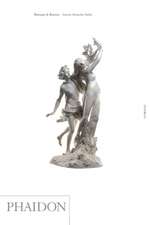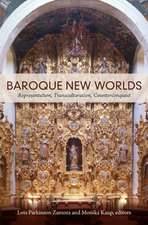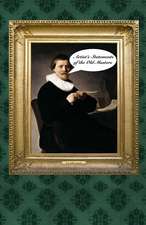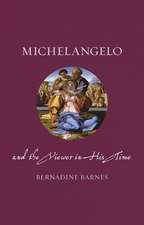Fragonard: Painting out of Time
Autor Satish Padiyaren Limba Engleză Hardback – 16 sep 2020
Preț: 276.61 lei
Preț vechi: 316.98 lei
-13% Nou
Puncte Express: 415
Preț estimativ în valută:
52.93€ • 55.26$ • 43.81£
52.93€ • 55.26$ • 43.81£
Carte disponibilă
Livrare economică 14-21 martie
Livrare express 27 februarie-05 martie pentru 93.09 lei
Preluare comenzi: 021 569.72.76
Specificații
ISBN-13: 9781789142099
ISBN-10: 1789142091
Pagini: 304
Ilustrații: 130 color plates
Dimensiuni: 191 x 248 x 23 mm
Greutate: 0.98 kg
Editura: REAKTION BOOKS
Colecția Reaktion Books
ISBN-10: 1789142091
Pagini: 304
Ilustrații: 130 color plates
Dimensiuni: 191 x 248 x 23 mm
Greutate: 0.98 kg
Editura: REAKTION BOOKS
Colecția Reaktion Books
Notă biografică
Satish Padiyar is an honorary research fellow at the Courtauld Institute of Art in London. His previous books include Chains: David, Canova, and the Fall of the Public Hero in Postrevolutionary France.
Recenzii
"The book is a thorough exploration, painting a picture of how he came to be and how his legacy lives on in contemporary culture. A book worth buying very much for the imagery, which is splashed onto pages with intense colours."
"Exhibitions such as Fragonard amoureux at the Musée du Luxembourg in 2015 have drawn helpful links with different aspects of eighteenth-century erotic culture, including the codes of galanterie and libertinage. All this has enriched the discourse, but it hasn’t changed the critical framework. Padiyar’s book strikes a different note. Although he doesn’t ignore erotic iconography, he considers Fragonard above all as a painter of time. The temporality that interests him resides not in a work’s relation to the past, or in its materials, but in its subject and visual structure. . . . Padiyar is convincing when he argues that in rejecting certain artistic norms Fragonard was adopting a politics—one that pursued not only sexual but also religious and political freedoms. It restores seriousness to a body of work often characterized by a certain légèreté, and to an artist who can seem light-hearted even in the manner of his death."
"What might cause an artist to quit? Perhaps the most famous example is Marcel Duchamp, who gave up making Dadaist art circa 1920 to play chess full-time. But Duchamp’s case was somewhat predictable—do enough “anti-art” and the whole project might begin to seem a bit pointless. For the eighteenth-century rococo artist Jean-Honorée Fragonard, however, the situation was more regrettable. Fragonard spent much of his life as a fashionable painter of genre decorations for members of the French aristocracy, but when these patrons began losing their heads in 1789, Fragonard lost his commissions. Never quite able to make the transition over to a more democratic kind of painting, Fragonard put his brushes down for the last time sometime in the early 1790s. Padiyar takes this moment as the starting point of his new investigation into Fragonard’s life and work, which focuses especially on the artist’s innovations in the field of drawing."
"Satish Padiyar, tries to get beneath the skin of this elusive painter who apparently preferred artistic freedom to material reward. His task is complicated by a dearth of biographical information. In an age of voluminous correspondence, Fragonard left no letters and no diaries. Even the accounts of his peers are sketchy and possibly misleading. When trying to understand a long-dead artist every biographical fragment is useful, but almost the only clues to Fragonard’s personality are to be discovered in his work. We don’t know what he was thinking when he painted erotic masterpieces such as The Swing (1767) or The Bolt (c.1778), but it’s fascinating to place these works within the cultural context of France in the last years of the ancien régime."
"Fragonard is a fascinating study and will appeal to specialists and general audiences alike. Padiyar captures the complexities of one of the most recognizable, albeit mysterious, eighteenth-century European artists and presents him in a relatable manner: as an individual trying to make sense of his own place in a society that did not suit him. Throughout his career, Fragonard was stuck in limbo; he fit in neither with the social expectations of the Académie nor with the aristocratic circle of his patrons. He was a bit old-fashioned, only beginning to work in the Rococo style at midcentury, but was also ahead of his time, rebelling against state-sanctioned practices and creating art that, in many ways, anticipated the expressive qualities of late nineteenth-century art making. Indeed, the Fragonard captured by Padiyar is 'out of time,' painting to the proverbial beat of his own drum, struggling to find his niche in the world he inhabits, and creating an oeuvre that brings viewers into an 'out of time, fantasy world.'"
"This is an outstanding contribution to a field the extent and depth of which are accommodated in a comprehensive bibliography. Its immaculate scholarship testifies to a mastery of earlier writing on Fragonard, whether by his contemporaries or in modern interpretations of the artist’s work. It is hugely enriched by its 114 illustrations. . . . This is a book which is intellectually stimulating and as beautifully written as it is produced."
"Padiyar argues that the key to the mysteries of Jean-Honoreì Fragonard’s life and work lies in the artist’s relationship to time. According to Padiyar, Fragonard (1732–1806) was 'out of time'—a belated master of a playful rococo idiom of surprise and instability... Padiyar’s book weaves in and out of Fragonard’s career, always tightly focused on the artist’s motivations and personality. In making his argument the author privileges formal analysis, supported by biographical evidence and strategic reference to eighteenth-century art theory and philosophy. Written in stylish, sophisticated prose, the study offers interpretations both of Fragonard’s most famous works and of less-known paintings and drawings. A valuable addition to the literature on eighteenth-century French art and culture. Recommended."
“A brilliant new account of Fragonard’s art that reveals some of its most intriguing secrets.”
“Deeply erudite. . . . Fragonard might be taken to embody brilliantly gifted eccentricity, but the author deploys that singularity in ways that illuminate the whole field of later eighteenth-century art.”
"A fresh approach to this quintessential French eighteenth-century artist, Padiyar’s book is also an innovative take on the genre of the monograph as it integrates biography and works in a novel and intelligent fashion. Making the most of the sparseness of information about Fragonard’s life, this beautifully written study weaves its narrative with discussions of the works along three themes: secrets, surprise, dreams. Surprising about the book itself is how the artist emerges as an entity from it, palpable in a way he has never been before."




















